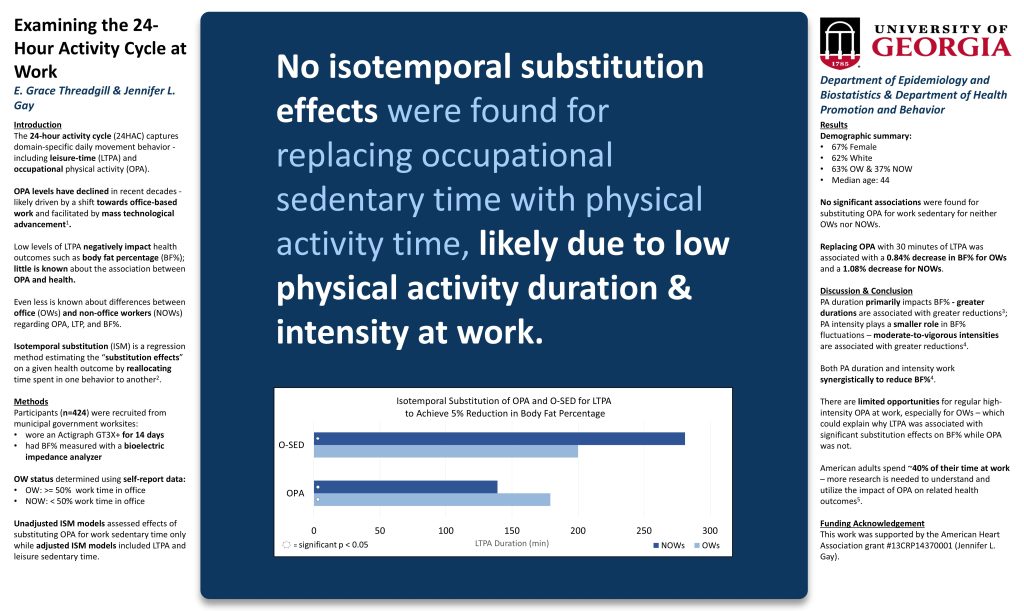
Authors: Threadgill, E. Grace & Gay, Jennifer L.
Institutions: University of Georgia, Department of Epidemiology and Biostatistics & Department of Health Promotion and Behavior
INTRODUCTION: The 24-hour activity cycle (24HAC) captures daily movement behavior including in specific domains of activity. Low levels of leisure time physical activity (LTPA) negatively impact health outcomes, such as body fat percentage (BF%), a biomarker contributing to myriad chronic diseases. However, evidence of the association between occupational physical activity (OPA) and health is mixed, with some evidence suggesting an OPA paradox. And even less is known about differences between office (OWs) and non-office workers (NOWs) regarding OPA, LTP, and BF%. Isotemporal substitution (ISM) is a regression method estimating the “substitution effects” on a given health outcome by reallocating time spent in one behavior to another. Applying ISM to work-delineated 24HAC may elucidate the association between OPA and health.
PUROSE: Examine effects of substituting OPA and LTPA for work sedentary time on BF% by OW status. METHODS: Participants (n=424) were recruited from municipal government worksites. A quota-sampling framework was applied to obtain representation across labor sectors. Participants self-reported demographic and occupational data (office worker = ≥50% time in an office), wore an Actigraph GT3X+ for 14 days and had BF% measured with a bioelectric impedance analyzer. OPA and LTPA minutes were classified based on self-reported working hours. Unadjusted models assessed effects of substituting OPA for work sedentary time only while adjusted models included LTPA and leisure sedentary time. RESULTS: Replacing OPA with 30-minutes of LTPA was associated with a 0.84% decrease in BF% for OWs (B=-0.028, 95% CI: (-0.051, -.0047), p=0.019) and a 1.08% decrease for NOWs (B=-0.036, 95% CI:(-0.067, -0.0047), p=0.025). No significant associations were found for substituting OPA for work sedentary time. CONCLUSION: OPA and work sedentary time alone did not correlate with BF%. Replacing OPA with ~36-minutes of LTPA for OWs and ~28-minutes for NOWs resulted in a 1% decrease in BF%. Given that many adults spend much of their time and accumulate 40% of their activity volume at work, researchers applying the 24HAC may need to consider occupation and assess the impact of OPA specifically on health outcomes.
What is isotemporal substitution? α
- “The isotemporal substitution model, by definition, estimates the effect of replacing one physical activity type with another physical activity type for the same amount of time”
- Substitution Model A
- Weight change = (b1) slow walking + (b2) brisk walking + (b3) jogging/running + (b4) other activities + (b5) total activity + (b6) covariates
- Include terms representing the time spent in each kind of activity as well as a term representing the total activity time (i.e. the sum of time spent in all activities)
- “By eliminating one activity component from the model (e.g., TV watching), the coefficient (b5) for total activity represents the omitted activity component (TV watching)”
- “The remaining coefficients represent the consequence of substituting 30 minutes of that activity instead of TV watching while holding other activity types constant”
α Mekary, R. A., Willett, W. C., Hu, F. B., & Ding, E. L. (2009). Isotemporal substitution paradigm for physical activity epidemiology and weight change. American journal of epidemiology, 170(4), 519–527. https://doi.org/10.1093/aje/kwp163
